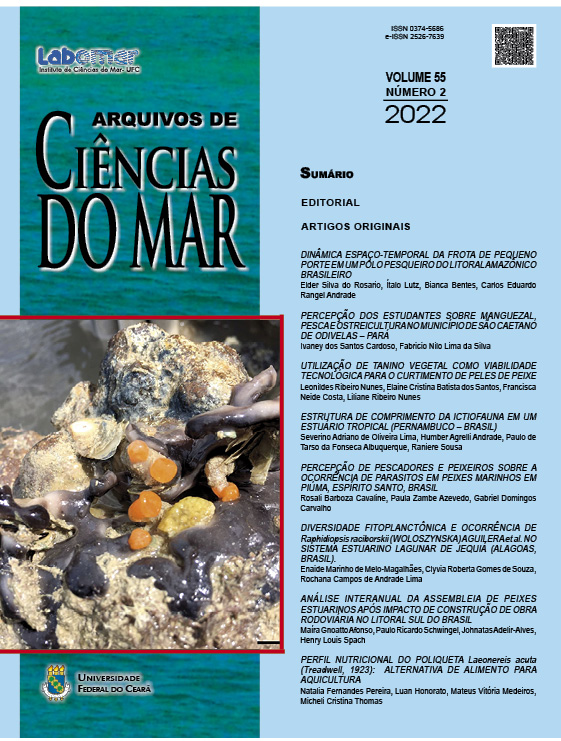Use of vegetable tanine as technological feasibility for fishing fish skin
DOI:
https://doi.org/10.32360/acmar.v55i2.70674Abstract
The objective of this study was to test the viability of vegetable tanning agents in freshwater fish skins, for the elaboration of fish leather, from three municipalities in the Baixada Maranhense. Training with the community on Good Fish Handling Practices (BPM) was carried out with the community, as well as workshops for using waste with the production of fish leather. Tambatinga and tambacu skins were submitted to the tanning process, using pomegranate (Punica granatum L.) and aroeira (Schinus terebinthifolius) as a source of vegetable tannins. The color analysis of the leather was performed by reading the RGB chroma patterns (Red, Green, Blue) by photographic record with images of high sharpness and evaluated by the Color editing software Paint. The analysis of the color variation of the tanned fish leather obtained a significance level of p < 0.05. Training on BPM and workshops for the production of fish leather aroused great interest in the communities, and the use of pomegranate and mastic as tanning agents was considered efficient in converting the skin into leather, turning it into a stable and non-rotable product, and the exotic design formed by the lamellae were maintained. The leathers obtained showed a different coloration between red and green, and can be used in handcrafted pieces. Tanning is of great environmental, social and international importance, reducing the generation of waste, obtaining a low-cost product, which can be commercialized and add value to family income.
Keywords: aroeira, pomegranate, tambaqui, tambacu, tannery.
Downloads
Published
Issue
Section
License
1. Proposta de Política para Periódicos de Acesso Livre
Autores que publicam nesta revista concordam com os seguintes termos:
- Autores mantém os direitos autorais e concedem à revista o direito de primeira publicação, com o trabalho simultaneamente licenciado sob a Licença Creative Commons Attribution que permite o compartilhamento do trabalho com reconhecimento da autoria e publicação inicial nesta revista.
- Autores têm autorização para assumir contratos adicionais separadamente, para distribuição não-exclusiva da versão do trabalho publicada nesta revista (ex.: publicar em repositório institucional ou como capítulo de livro), com reconhecimento de autoria e publicação inicial nesta revista.
- Autores têm permissão e são estimulados a publicar e distribuir seu trabalho online (ex.: em repositórios institucionais ou na sua página pessoal) a qualquer ponto antes ou durante o processo editorial, já que isso pode gerar alterações produtivas, bem como aumentar o impacto e a citação do trabalho publicado (Veja O Efeito do Acesso Livre).

